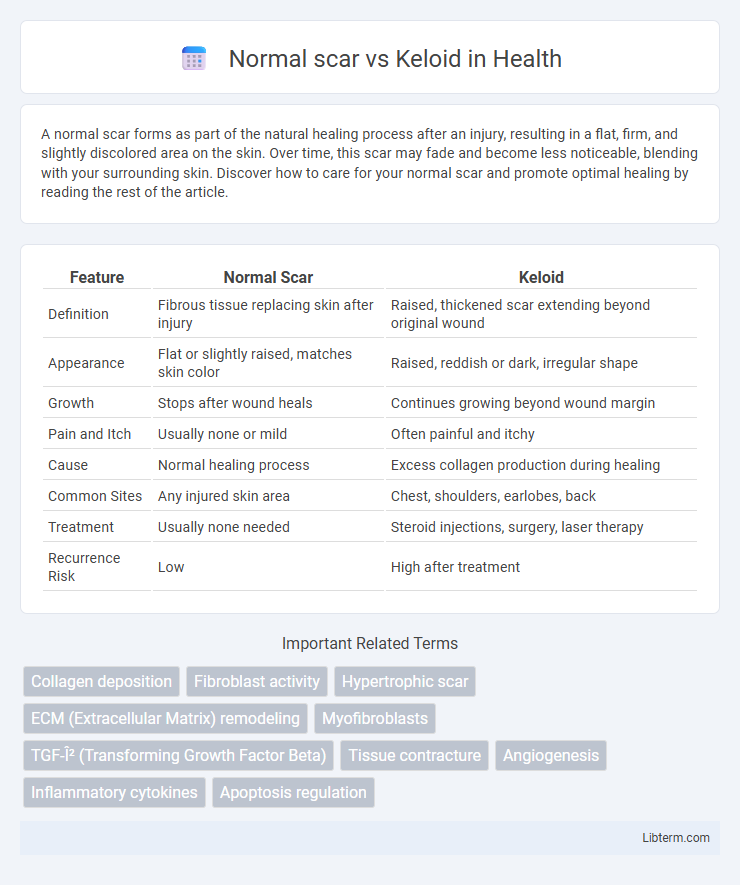A normal scar forms as part of the natural healing process after an injury, resulting in a flat, firm, and slightly discolored area on the skin. Over time, this scar may fade and become less noticeable, blending with your surrounding skin. Discover how to care for your normal scar and promote optimal healing by reading the rest of the article.
Table of Comparison
| Feature | Normal Scar | Keloid |
|---|---|---|
| Definition | Fibrous tissue replacing skin after injury | Raised, thickened scar extending beyond original wound |
| Appearance | Flat or slightly raised, matches skin color | Raised, reddish or dark, irregular shape |
| Growth | Stops after wound heals | Continues growing beyond wound margin |
| Pain and Itch | Usually none or mild | Often painful and itchy |
| Cause | Normal healing process | Excess collagen production during healing |
| Common Sites | Any injured skin area | Chest, shoulders, earlobes, back |
| Treatment | Usually none needed | Steroid injections, surgery, laser therapy |
| Recurrence Risk | Low | High after treatment |
Understanding Scars: Normal vs Keloid
Normal scars result from the natural healing process where collagen fibers align in a flat, thin pattern, blending with surrounding skin, typically fading over time. Keloid scars form due to excessive collagen production, creating raised, thick, and often itchy or painful lesions that extend beyond the original wound boundaries. Understanding the cellular mechanisms and genetic predispositions behind keloid formation is crucial for developing targeted treatments and preventing abnormal scar growth.
What Causes Normal Scars?
Normal scars form as a natural part of the skin's healing process after injury, where fibroblasts produce collagen to close the wound efficiently. These scars result from balanced collagen production and degradation, typically aligning with the original skin structure without excessive tissue buildup. Unlike keloid scars, normal scars do not grow beyond the wound boundary and generally fade over time.
Key Characteristics of Keloid Scars
Keloid scars are characterized by excessive collagen buildup that extends beyond the original wound boundaries, leading to raised, thickened, and often itchy or painful tissue. Unlike normal scars, which typically fade and flatten over time, keloids persist, grow progressively, and can cause functional impairment or cosmetic concerns. Their tendency to recur after treatment and their disproportionate response to skin injury distinguish keloid scars in clinical management and dermatological studies.
Differences in Healing Processes
Normal scars result from a balanced healing process where collagen production and degradation are well-regulated, leading to a flat, thin, and often less noticeable mark. Keloid scars form due to excessive collagen accumulation caused by abnormal fibroblast activity, extending beyond the original wound boundaries and resulting in raised, thick, and often itchy or painful tissue. The prolonged inflammatory phase and altered cellular signaling in keloid scars disrupt typical tissue remodeling, making them resistant to conventional healing and prone to recurrence.
Risk Factors for Keloid Formation
Keloid formation risk factors include genetic predisposition, with higher incidence in individuals of African, Hispanic, or Asian descent, and a family history of keloids increasing susceptibility. Skin trauma severity, such as deep wounds, burns, surgical incisions, and infection, significantly elevates the risk of abnormal scar proliferation. Age also influences keloid risk, most commonly affecting individuals between 10 and 30 years old, while areas of high skin tension like the chest, shoulders, and earlobes are more prone to keloid development.
Appearance: Normal Scar vs Keloid
A normal scar typically appears as a flat, thin line that gradually fades to a lighter color similar to the surrounding skin, maintaining a smooth texture. In contrast, a keloid scar is raised, thick, and often extends beyond the original wound boundaries, displaying a shiny, firm surface with a reddish or purplish hue. Keloids may also exhibit irregular, lumpy shapes, whereas normal scars remain more uniform and less conspicuous over time.
Common Body Areas for Keloids
Keloids commonly develop on the chest, shoulders, earlobes, and upper back, where skin tension and trauma often trigger excessive collagen formation beyond normal scar boundaries. Unlike normal scars that remain confined to the wound area, keloids grow outward and can cause discomfort or itching. These raised, thickened scars are more prevalent in individuals with darker skin tones and can pose cosmetic concerns requiring targeted treatments.
Symptoms and Complications
Normal scars typically appear flat, pale, and fade over time, causing minimal discomfort or functional impairment. Keloids present as raised, thickened, and often erythematous growths extending beyond the original wound boundary, commonly associated with itching, pain, and restricted movement. Unlike normal scars, keloids have a higher risk of recurrence and can lead to significant cosmetic disfigurement and psychological distress.
Treatment Options for Normal vs Keloid Scars
Treatment options for normal scars typically involve silicone gel sheets, pressure therapy, and topical treatments such as vitamin E or corticosteroid creams to reduce redness and improve texture. Keloid scars often require more aggressive interventions, including intralesional corticosteroid injections, laser therapy, cryotherapy, or surgical excision combined with postoperative radiotherapy to prevent recurrence. Emerging treatments like 5-fluorouracil and interferon injections show promise in managing keloids by inhibiting fibroblast proliferation and collagen synthesis.
Prevention Tips for Keloid Scarring
Normal scars typically heal within the skin's natural boundaries, while keloid scars extend beyond the original wound and are characterized by excessive collagen production. Preventing keloid scarring involves minimizing skin trauma by avoiding unnecessary piercings or surgeries, applying silicone gel sheets or pressure dressings to healing wounds, and keeping the area moisturized and protected from sun exposure to reduce inflammation. Early intervention with corticosteroid injections or laser therapy can also help inhibit abnormal scar formation in individuals prone to keloids.
Normal scar Infographic

 libterm.com
libterm.com